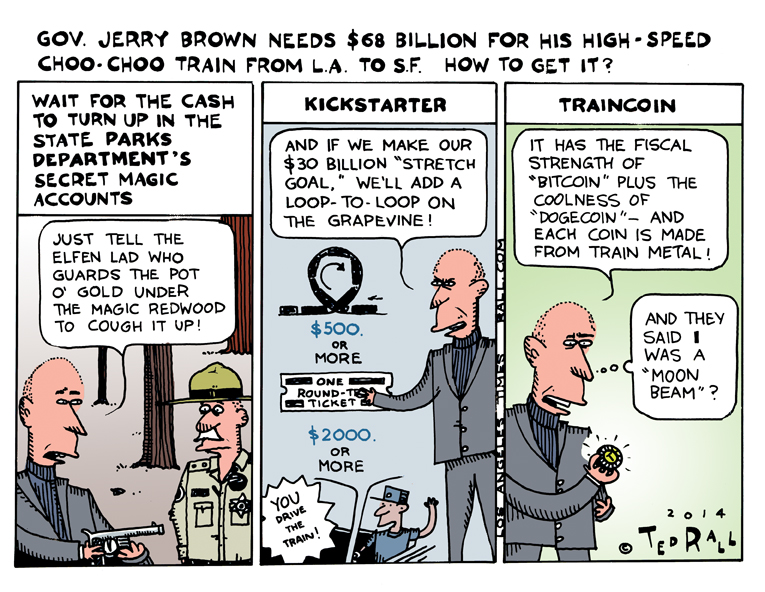I draw cartoons for The Los Angeles Times about issues related to California and the Southland (metro Los Angeles).
This week:
Gov. Jerry Brown has a dream, a dream that would serve as his greatest legacy — a high-speed train that would slash the six-hour drive from Los Angeles to San Francisco to a relaxing ride a smidge over two hours.
It may seem like a pipe dream now, but similar links have transformed other countries. When I visited Paris as a kid, the eastern city of Strasbourg was a weird, remote border town where people spoke German and claimed to like black blood sausages. Thanks to France’s TGV trains, an all-day schlep is a quick day trip — two hours each way — which paved the way for Strasbourg to become an important headquarters for EU bureaucrats and Eurozone business types. Moreover, two hours on the train are not like two hours behind the wheel of a car. You can get a lot of work done on a train.
It doesn’t take a big stretch of imagination to see why Silicon Valley and Hollywood might want to work together more closely.
Unfortunately, Brown is having trouble scaring up the $68 billion estimated total cost of the project.
Fortunately, money seems to be easy to find these days.
California’s parks department, for example, used to be in the habit of squirreling away tens of millions of dollars for a rainy day — in the middle of a budgetary typhoon. Maybe they have a few bucks under the cushions now?
Geeks are willing to fund just about anything on Kickstarter. Sure, people are starving, but how about $67,000 for a statue of the fictional character Robocop?
Then there are like 70 “alternative” cybercurrencies, all based on, well, nothing. If catcoins and dogecoins and sexcoins can convince people to part with real (“fiat”) money, why not traincoin?


1 Comment.
Not to get too far down the rabbit hole on cryptocurrencies, but I see nothing more — or less — bizarre about them, compared with bits of paper and hunks of base metal. As was covered a few items back, the notion of these bits of currency is that they are a method to make trade of goods and services possible with a minimum amount of aggravation (“I don’t have three chickens. Will you take your change in cows?”)
I think the bigger problem with a high-speed train is that they’re always being sold as “solutions” to commuters traveling between two population-dense locations. A far more practical use is to connect metropolitan locations with outlying low-density locales. Look at the Poconos and New York City. With a bullet train, it would be half an hour between the two. I’d live in the Poconos if I could get to work in half an hour. Not while it’s still a 2.5 hour trip by car.